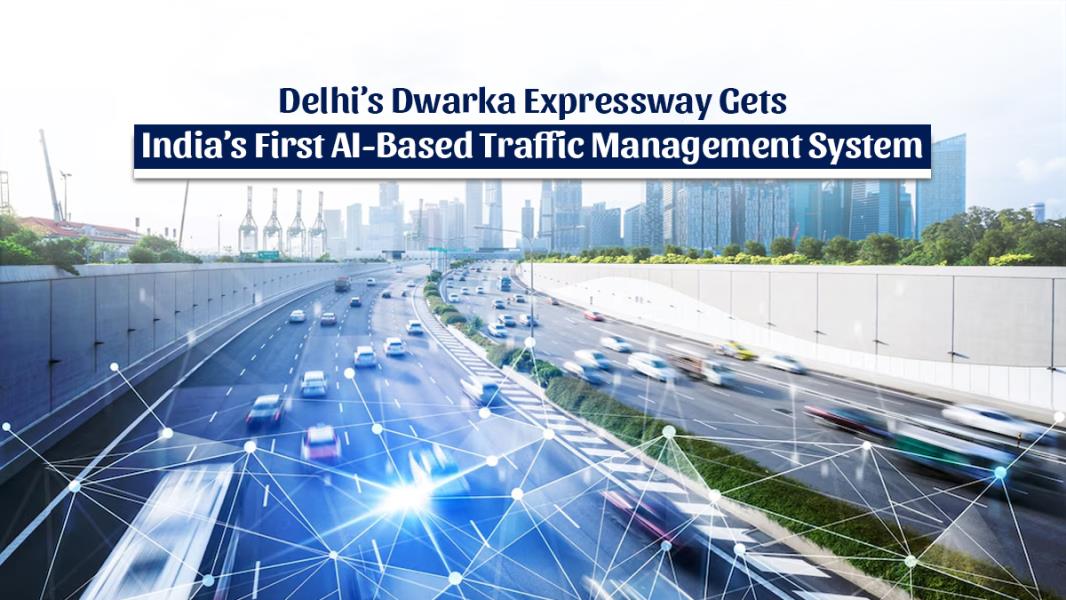Delhi’s Dwarka Expressway Gets India’s First AI-Based Traffic Management System
By Amit Jangra | Published Date : July 05, 2025
India launched its first AI-based traffic system on Delhi’s Dwarka Expressway, using smart cameras and real-time monitoring to improve road safety, manage traffic and issue instant fines.
If you have driven on the Dwarka Expressway recently, you might not have noticed it right away but the highway is now under the watchful eye of artificial intelligence. India just rolled out its first-ever AI-based traffic control system and it’s up and running across a 56-kilometer stretch between Shiv Murti and Kherki Daula, touching part of NH-48.
This upgrade is not just a tech stunt. It’s part of the NHAI’s (National Highways Authority of India) broader goal to build roads that aren’t just wider or faster but smarter and safer.
How the AI Traffic System Works

Table of Contents
| 1. How the AI Traffic System Works |
| 2. Smart Detection and Warnings |
| 3. Smart Features for Safer Driving |
| 4. The Digital Brain Behind It All |
| 5. Real-Time Fines and Safer Roads |
| 6. A Model for the Future |
| 7. Final Words |
Also Read - BharatBenz Launches HX and Torqshift Series for Mining and Construction Market
Let’s be honest when we hear “AI traffic system,” most of us imagine a bunch of cameras clicking photos and spitting out challans. But there’s more to it.
Picture them like tireless traffic watchers they never blink, never miss a thing. Whether it’s a hatchback, a truck, a delivery van or even a noisy bus, they are watching. All of it. All the time.
Smart Detection and Warnings
The real genius lies in a system called VIDES short for Video Incident Detection and Enforcement System. Instead of relying on police at every turn, this setup flags violations the second they happen. Speeding? Not wearing a seatbelt? Three people on a two-wheeler? It sees it.
Smart Features for Safer Driving
Let’s give drivers some credit. Most want to follow the rules, but sometimes they just don’t realize they’re speeding. That’s where Vehicle Actuated Speed Displays (VASDs) come in. These boards flash your actual speed as you drive past a gentle but firm reminder to slow down if you are pushing it.
Then there are Variable Message Sign Boards (VMS). These are not just generic safety slogans they update in real time. Fog ahead? Crash up the road? You will see the warning before you hit trouble.
The Digital Brain Behind It All
Behind this setup is a command and control centre, which acts as the system’s nerve center. All the camera feeds, alerts and incident data flow here. And when something goes wrong like an accident, a cow on the road, or a weather issue the team can respond much faster than before.
Real-Time Fines and Safer Roads
According to Amrit Singha, Chief Product Officer at IHMCL, this AI setup can spot 14 different types of violations all linked to the Motor Vehicles Act. And here’s the twist: once a rule is broken, the information is instantly sent to the NIC e-challan portal. No delays, no paperwork, just straight-up digital enforcement.
A Model for the Future
NHAI is treating the Dwarka Expressway as a testbed and if things go well (which early signs suggest they are), more highways across India could soon adopt similar systems.
But this isn’t just about catching people doing the wrong thing. It’s about data. Constant, real-time insights help authorities design better infrastructure, adjust speed limits intelligently and ultimately reduce accidents.
Final Words
It’s not some futuristic idea anymore it’s already rolling out. You might not even notice it at first, but AI is slowly reshaping how our highways work. Sure, it feels a bit strange at first tech watching every move on the road but think about what we gain: fewer accidents, quicker help in emergencies and smarter road design. That’s a pretty solid trade-off.
India’s first smart expressway could be the blueprint for the future. One where roads are no longer just concrete paths but intelligent, responsive systems that protect the people on them.
Also Read - Eicher Sets Up New Dealership for Pro X Small Trucks in Delhi
Join us for latest updates on Truck Industry -
⇒ Facebook
⇒ Instagram
⇒ YouTube
Frequently Asked Questions on Trucks
1. How does the new AI traffic system affect trucks on the Dwarka Expressway?
Ans: The AI-powered system uses 110 high-resolution cameras and advanced technology to monitor truck movements, ensuring compliance with traffic rules and enhancing road safety.
2. Are trucks allowed on the Dwarka Expressway?
Ans: Yes, trucks are permitted, but they must adhere to specific guidelines, including speed limits and lane discipline, to ensure smooth traffic flow and safety.
3. What types of violations can the AI system detect concerning trucks?
Ans: The system can identify various violations such as over-speeding, lane infringement and other traffic rule breaches, ensuring prompt enforcement.
4. Will trucks receive fines for violations detected by the AI system?
Ans: Yes, the system is integrated with the e-challan portal, allowing for the immediate issuance of fines for detected violations and promoting accountability among truck drivers.
About the Author

Amit Jangra
Amit Jangra is a dedicated content writer at TrucksBuses.com, a leading Indian portal for commercial vehicle insights. With a strong background in social work and a passion for the transportation sector, Amit brings a unique perspective to his writing. His articles are known for their clarity and depth, making complex topics accessible to a broad audience. Amit's commitment to empowering readers through informative content reflects his broader mission of societal upliftment.